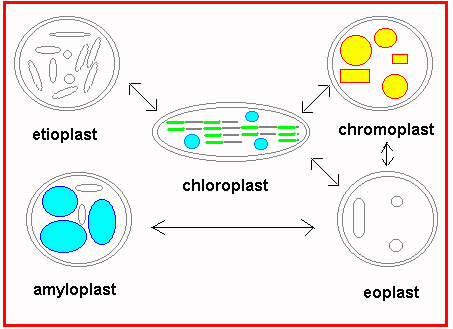|
|
|
|
|
PLANT CELLS |
|
Cellular basis of growth
Each of these processes is necessary for sustained and organized growth. Cell division or mitosis involves the duplication and orderly separation of complete sets of genetic material. As cells expand this genetic material is selectively transcribed and translated to determine the final shape of each cell. So cells end up different shapes according to their position and function in the plant. In other words they undergo differentiation. The Plant Cell
The composition and structure of the cell wall are important aspects of differentiation. |
|
|
Within the wall, and usually pressed up against it is the plasma membrane (PM). This membrane regulates the uptake and exit of molecules and ions; it is involved in sensing signals from the environment and other cells in the plant and in cellulose synthesis. In addition to this external boundary, plant cells have an internal boundary, the tonoplast (TP) which encloses the vacuole. |
|
|
Expansion of plant cells occurs mainly in the vacuole so that this is the largest compartment of most mature cells.
The organelles and most of the metabolic apparatus of the plant cell exist in the cytoplasm, between the plasma membrane and tonoplast Chloroplasts with their role in photosynthesis are just one member of a family of organelles that are all enclosed by double lipid membranes. Other members of this family of plastids have other functions and include
Plastids contain DNA that encodes some of their proteins (others are encoded by the nucleus) and they reproduce by division. Eoplasts develop into the other forms of plastid, depending on the kind of tissue where they occur. All of the forms of plastid are interconvertible. Much of fall color is the result of the transition from chloroplast to chromoplast in the leaves of deciduous trees.  |
|
|
This plastid from a young strawberry fruit is intermediate between a chloroplast (presence of thylakoid) and an amyloplast (large starch grains) |
|
|
Other membrane -bound organelles in the plant cell are typical of all eukaryotes: |
|
|
The nucleus is the site of most of the genetic information in the cell. It is bounded by a double membrane which is perforated all over with pores. Proteins and other molecules from the outside world can enter these pores and affect nuclear function. RNA (mRNA, tRNA and rRNA) that is transcribed from DNA in the nucleus passes out through the pores to the cytoplasm where it is involved in protein synthesis. Ribosomal RNA synthesis is concentrated in the nucleolus (1) which is the usually the most obvious structure visible in the nucleus. |
|
|
The mitochondrion is another double membrane bounded organelle with some of its own DNA and protein synthesis apparatus. As with the chloroplast, the synthesis of mitochondrial proteins is shared between the mitochodrion itself and the nucleus. Like the plastid and nucleus it reproduces by division. The role of mitochondria in respiration is described elsewhere |
|
|
Endoplasmic reticulum (ER) occurs as sheets of membrane throughout the cytoplasm; it is often associated with ribosomes (rough ER) but may also be smooth. The ER is involved in processing proteins and movement of molecules around the cell. |
|
|
The Golgi apparatus or dictyosome is a stack of saucer like membranes which generate little vesicles at the edges. It is involved in secretion of material, particularly cell wall components through the plasma membrane. |
|
|
The cytoskeleton is made up of actin filaments which are responsible for cytoplasmic movement and microtubules that organize cell wall assembly and chromosome movement in mitosis. Although plants themselves do not move there is plenty of movement inside their cells. |
|
|
In addition to the actin and tubulin systems, membranes provide a pathway of movement. New lipid produced in the ER, moves to the Golgi apparatus where it picks up material for secretion. Vesicles from the Golgi pass out of the cell, delivering packages of cell wall material as they fuse with the plasma membrane. |
|
|
An interesting view of the plant cell is given at a Web site maintained by the University of Illinois. Their Virtual Cell is a clickable map of structures in the plant cell as seen with the electron microscope and in diagrammatic form. Copyright © Michael Knee, |
|